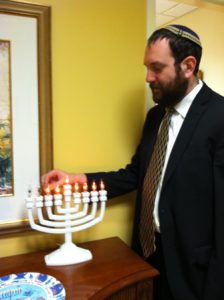 Many holidays have celebratory symbols that visually represent the essence of the day and why it is celebrated. In the United States, such symbols are in abundance during the winter holidays, especially those of Christmas, Hanukkah and Kwanzaa. We see decorations hanging on homes and in stores, malls and other public places. Each holiday and its symbols have unique messages to share about living together in this melting pot we call America.
Many holidays have celebratory symbols that visually represent the essence of the day and why it is celebrated. In the United States, such symbols are in abundance during the winter holidays, especially those of Christmas, Hanukkah and Kwanzaa. We see decorations hanging on homes and in stores, malls and other public places. Each holiday and its symbols have unique messages to share about living together in this melting pot we call America.
For Hanukkah, the symbol most associated with the holiday is the Hanukkah menorah, the nine branched candelabra used by Jews when lighting candles each night of the festival. What does the menorah symbolize for us?
The lighting of the menorah represents the miracles experienced by the Maccabees over two thousand years ago. In 167 BCE, the Maccabees were victorious in reclaiming control of Israel from the Greeks. When they returned to the Temple Mount in Jerusalem, finding the Temple desecrated and defiled, the Maccabees began working to rededicate the Second Temple. As part of the re-dedication, they went about trying to revive the Temple rituals, including the lighting of the Menorah, the seven branched candelabra that stood at the entrance to the Temple. The Maccabees went searching for pure olive oil, which was required in order to light the candles, but all they found was one small jar which was not even enough to light the menorah for one whole day. Miraculously though, this little amount of oil continued to burn for eight consecutive days.
In modern Jewish practice, the tradition is to light a candelabrum that has nine lights, one for each of the eight nights of Hanukkah and a central candle, the shamash, from which the other candles are lit. On the first night of Hanukkah one candle is lit, and then each subsequent night one candle is added. By the end of the eight-day holiday, the entire candelabra of eight candles are lit along with the shamash. The reason for this practice is to rise in holiness each day as we count the eight days of the holiday.
But what does it mean to rise in holiness by adding candles? Holiness is most often seen as something separate from day to day life, something above and beyond the ordinary. However, to truly be holy does not come from what we do in solitude. True holiness includes the ability to be in the presence of other people in a way that helps spread spirituality and good through the world. The lights of Hanukkah beautifully symbolize this spreading of light. On the first night, we have one candle, which brings light into a dark place. Each subsequent night we add one candle, enhancing the experience of light breaking through in difficult times. Without all the candles coming together, the light doesn’t grow, but remains small. So too with holiness. One act of holiness can raise us above the mundane, but one act, alone, by one person, is not enough. Without each of us coming together to do holy work, the single acts remain small and they do not raise holiness. When holy acts are brought together, spirituality will radiate and permeate into everything.
In this time of celebration, let us rejoice in our ability to come together, rising above what separates us, for when we are together, we can truly brighten up the world.
The Oscar and Ella Wilf Campus for Senior Living is comprised of Stein Assisted Living and the Jaffa Gate Memory Care Neighborhood, Stein Hospice, Wisentz Senior Residence, Wilf Transport, and The Foundation at the Wilf Campus. For more information, contact us at (732) 568-1155, [email protected] or visit us at www.wilfcampus.org.
